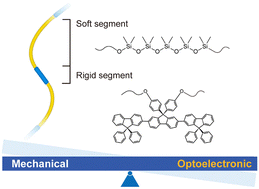Light-emitting polymers with tunable mechanical properties are desirable for flexible optoelectronic devices. Herein, adopting the synthetic routes for polyurethanes (PU), we successfully developed a series of blue light-emitting copolymers by incorporating a diarylfluorene-based trimer (a rigid segment) and polydimethylsiloxane (PDMS) (a soft segment) with precisely tunable mechanical properties from brittleness to viscoelasticity. The impact of varied soft-to-rigid ratios on the balance of the mechanical and optoelectronic properties was thoroughly investigated combining thermodynamic analysis and tensile testing of free-standing films and solution-processed polymer light-emitting diodes (PLEDs). These copolymers maintained efficient deep-blue emission regardless of the segment ratio, and PLEDs based on these copolymers (the content of PDMS < 30%) also exhibited comparable performances with a turn-on voltage of ∼4 V. This study highlights the importance of achieving the optimal balance between the mechanical and optoelectronic properties in materials design, providing critical insights for developing flexible optoelectronic polymers.
